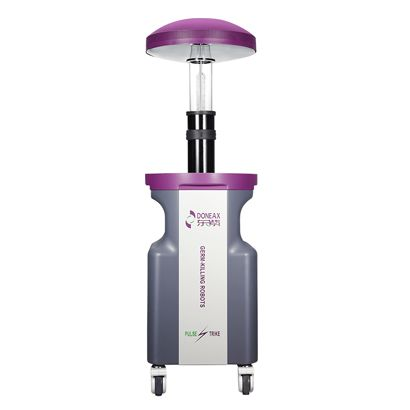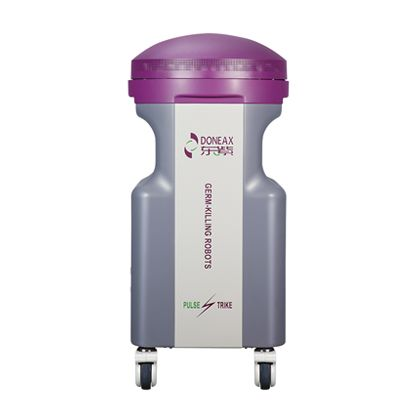Pulsed UV Light Robot Hospital Disinfection: Ultimate Guide
2022-03-01 by hqt
Disinfection of surfaces and air with UV technology

Pulsed UV light robot hospital disinfection penetrates the cell wall of microorganisms, altering their DNA, destroying all types of viruses and bacteria.
Get Guaranteed Hospital Disinfection
Using our disinfection robots, you get safe and clean surrounding within 5 minutes. Furthermore, it leaves no chemical residue. In addition, its capacity to kill viruses is huge.
These robots come with intelligent cloud-based software that is activated during the required time that generates the recommended ultraviolet spectrum of 200nm-315nm. It is designed to solve the health problems of companies in different sectors:
- Industrial ships
- Public Transport (Metro, Bus, Light Rail)
- Hotels
- Airports / Terminals
- Airlines
- Hospitals
- Offices
- Gyms
- Cinemas / Theaters
- schools
How does pulsed UV light robot hospital disinfection work?
The system of disinfection robot is quite simple. It works on smart intelligent system that makes it better and smarter in terms of performance. There is no need for manual input. Moreover, it provides rapid results.
Why uv disinfection?
Ultraviolet disinfection is the process of inactivating viruses, the outer wall of which is covered with an oil layer, by exposing them to a certain range of ultraviolet light with the help of a UV disinfection lamp.
The areas of application for pulsed UV light robot hospital disinfection in health are diverse: As a hygiene robot or part of an industrial conveyor belt, for example, the professional robots minimize germs.
What is important, however, is that this device provides maximum disinfection with complete satisfaction in populated hospitals. For example, luminous robots walk alone through some operating theaters and hospital rooms around the world.
Pulsed UV light robot for domestic use
Disinfectants are in short supply right now – and are particularly needed by professional medical staff. It’s understandable that people concerned about contracting COVID-19 are looking for ways to protect themselves in other ways – not just with masks or gloves, but perhaps with pulsed UV light robot hospital disinfection that are supposedly easy to use.
Highly efficient in the right place
The genetic building blocks adenine, guanine, cytosine and thymine in particular absorb the UV-C light and it is rendered harmless – the germs can no longer multiply. This effect is known from studies and is safe. They are also known for types of viruses, according:
Obviously it also works with corona viruses: with model viruses from the group of corona viruses, such as the murine corona virus, experiments have been carried out in which UV light has an effect. This also applies to a SARS virus, which we have known for a long time.
It has been effective and research has also been carried out on the MERS virus and it has been seen that pulsed UV light robot hospital disinfection is effective there.”
Sterilization with ultraviolet rays is the complete destruction of harmful bacteria and viruses by exposing them to light of a certain wavelength with the help of a virus-killing UV Lamp.
Pulsed UV light robot hospital disinfection also effective against corona virus
The device also offers effective and successful disinfection when fighting the corona virus! The DNA of the corona virus is damaged by UV-C radiation in the same way as any other virus.

Especially in countries like China or Europe, which were particularly affected by the first wave of the pandemic, the UV robot has already been used successfully to disinfect rooms and even entire hospitals.
Delta/omicron variant and other corona mutations
The disinfection robot is also effective against all mutations of the corona virus, including the delta and omicron variants. This is because the mutations in the virus only affect the spike proteins that the virus uses to attach itself to the host cell. The DNA of the virus, on the other hand, continues to be destroyed by UV-C light.
Fight viruses and bacteria with UV-C radiation
The UV disinfection robot from UVD-Robots is used to disinfect rooms in hospitals, clinics, medical practices and laboratories. This UV disinfection device scans the room fully automatically and irradiates every surface to be disinfected with UV light. Since the emitted short-wave UV-C radiation is very high in energy, viruses and bacteria are reliably killed.
Pulsed UV light robot hospital disinfection works on damage to viral DNA during exposure to ultraviolet light. The UV-C light used here with a wavelength of 315 nm has proven to be particularly effective in combating viruses and bacteria. Pathogens damaged in this way can no longer reproduce and die off.
What is UV wavelength?
UV light can be summarized as the visibility/power of the scattered light. It can be defined as the light (Ultraviolet Radiation) between 400 nm and 10 nm wave value, which is outside the visible light band cluster. In this context, UV is divided into 5 classes according to its wave value. If it is necessary to sort the distribution of UV light according to wavelength;
- Vacuum UV 10-200 nm
- UVGI 253.7(254)nm
- UV-C 200-280 nm
- UV-B 280-315 nm
- UV-A 315-400 nm
UV rays can be preferred for both disinfection and sterilization purposes. Disinfection and sterilization differ. Sterilization is the name given to the process of purifying an object from all microorganisms on its surface or content.
After this process, all pathogens and non-pathogenic microorganisms are destroyed. Disinfection means controlling pathogenic microorganisms. Although there may be levels and criteria of the disinfection process, there are no stages of sterilization.
A product or area is either sterile or not, with no middle ground. The level of disinfection may differ according to the object or environment to be applied, the microorganism value contained in the area where it is used, and the microorganism value allowed to reside in the area or object to be disinfected.
Summary
Due to the effective use of high-power advanced pulsed UV light robot hospital disinfection and efficient energy consumption, this technology has been increasingly used. These robots emit such high-energy pulses that the energy accumulated in the microorganism causes a serious heating and the cell is destroyed.

